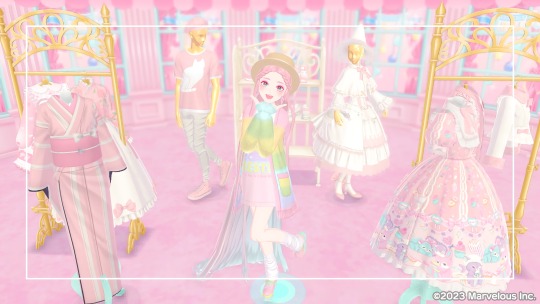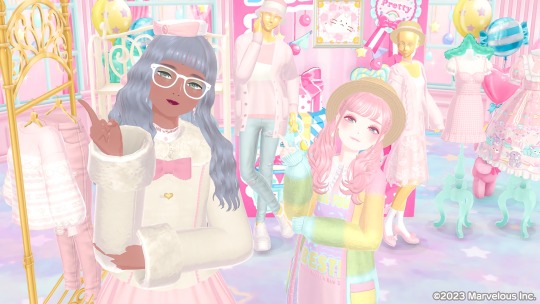#I got orihimes super long hair so I’m using it for now! haha
Text




I updated my showroom! ♡ Tons of pink!
ID: Dv34ebRXV8
#Feel free to request a lookit from me! I love doing them! ☺️💖 (I do have more than just pink clothes haha)#I got orihimes super long hair so I’m using it for now! haha#fashion dreamer#nintendo#nintendo switch#cozy games#cozy gaming community#cute#pink#fashion#video games
265 notes
·
View notes
Text
Stars over Sendai
A good evening after a long day again!
I had agreed to meet up with my Japanese friend at Sendai station, so I got up early and drove the (this time correct) train to Omiya in Saitama, from where I caught the Hayabusa shinkansen to Sendai. It took slightly over an hour then to make it to Sendai at 10 AM, just when all the festivities would have started. I met my friend and together we quickly already reserved train tickets for the way back, since the Tanabata festival draws in about 2 million visitors each year… Obviously not all at the same moment, but the trains were definitely busy.
After that, travel time! We sought out the bus stop for the loop bus, very creatively called the Loople Bus, which looks like a cute retro bus and loops around the main attractions in the city in one direction. You can get a day pass which also gives you discounts, so naturally, we went with that.
Our first stop after early lunch was the Zuihoden mausoleum. It’s actually a complex of several mausolea of Date Masamune, a famous samurai lord, and his heirs. Masamuna was known as the ‘one-eyed dragon’ (since he had one eye, you see), and was one of the most powerful daimyo (lords) in the region. He was the founder of Sendai city, so it’s a name you see a lot here. His traditional appearance is very striking since he’s known for his golden headgear, shaped like a crescent moon. He’s also the one who appreciated the Tanabata festival so much that it became such a big deal in Sendai, though we’ll be getting to that later.
Actually, the Zuihoden and the other buildings are all rebuilt: at the end of World War 2, Sendai was bombed and the buildings burnt down. The reconstructions were done in the original style, and though that does mean they look very flashy and new, it does give off a genuine feeling.
It is quite the uphill walk to the Zuihoden, the actual mausoleum of Masamune where they’ve enshrined a wooden statue of him. On the corners of the mausoleum, you can spot dragon heads, true to his nickname. There’s also a museum right next to it, which opened with information about Tanabata until you got into the real exhibition: that of excavated items found when the mausolea for the second and third Date lords were reconstructed. This was super interesting, because they’d found remains of both the three lords as well as their swords and armors. No replicas, but the real deals, and in pretty good condition at that. They also had replicas of their skulls on display along with facial reconstructions, and actual bone and hair fragments of Masamune, which is both a little creepy as well as fascinating, because he lived in the 17th century. And here we were, four hundred years later, and they had been able to tell from his bones exactly how tall he’d been and what his blood type was. Masamune also sympathized with foreign causes, meaning he was interested in technology from outside Japan and didn’t exactly like the presecutions of Christians that the shogun Tokugawa Ieyasu insisted upon, although there was little he could do about it. (Make no mistake, he was still a brutal warlord.) Anyway, it also meant that they’d uncovered the remains of a pair of glasses for one of the other two lords. Impressive.
We made our way to the other two mausolea next, the Kansenden for Date Tadamune and the Zennoden for Date Tsunamune, second and third daimyo respectively. They look pretty much alike, and these too are rebuilds after being destroyed in the fires. There were also stone tablets for numerous other Date lords, including one that only lived to the age of 17. Nice times, you can tell.
Anyway, after the interesting history lesson, we made our way back out again, past the now put up Tanabata decorations and the warning plates for wasps (understandable), snakes (… right, we’re on the other side of the planet here), and bears (wait, come again?). The Loople Bus had just arrived, so we ran for it and made it, along with the fifty or so other people who wanted to get on. I’m still amazed that we all fit, because these buses look tiny, but I guess the Japanese are just used to being crammed into vehicles? Anyway, we got off two stops later, to something I had been really looking forward to: Sendai or Aoba Castle.
Truth being told, not a whole lot is left of it. Very unsurprisingly, Date Masamune started the construction of this castle, although a main keep was never finished. The whole castle mostly served as headquarters and administrative center rather than a defensive force, and it was destroyed a couple of times in earthquakes and fires. By 1870, most of the castle was dismantled after the downfall of the shogunate, and in 1945, whatever remained was destroyed completely.
All that’s left is the outer stone walls and a guard tower, and it’s quite a climb to get there as it’s on a mountain top (Aoba mountain), looking out over the city of Sendai. Atop is a statue of Masamune on horseback, which is a pretty iconic statue you’ll see constantly if you visit Sendai.
The view was great, and we could actually spot the great Kannon statue in the distance once the clouds shifted a bit (it was cloudy all day, but not a drop of rain). It’s white, so that was a startling sight, haha. (I wanted to visit it, but it’s on the opposite end of the city. It IS the second tallest statue in Japan though, at 100 metres tall. Maybe next time!)
Walking around the premises, we came across a group of actors carrying a paper mached version of Masamune over to the main area, where they re-enacted one of the famous battles, haha. It was fun, though mostly for the kids present. Instead, we made our way to the Aoba Castle museum, which has assorted artifacts and scale models of the castle. It’s a bit tricky if you don’t speak Japanese (or are too tired to really focus at this point, like me, haha), because there’s no information in English at all. There’s a movie playing with more information about the castle, which is really interesting, even if it’s narrated by two talking birds and a talking soy bean, haha. Apparently head sets with English audio were available, but I missed out on those. Just for the record!
I was getting pretty tired, but I really liked the visit to this castle, even though not a whole lot is left of it. (It still made the Top 100 anyway, because half that top is ruins, I swear.) With it being close to 5 o’clock, all major attractions were closing anyway, so it was time to go into the direction of the station – time for Tanabata!
The Tanabata Festival finds its roots in a star-crossed lovers story, literally. It involves the stars Vega and Altair, or Orihime (the weaving princess) and Hikoboshi (cow herder). Orihime weaved clothes for her father the sky king, but once she fell in love with Hikoboshi from across the river known as the Milky Way, she neglected her weaving and Hikoboshi let his cows run wild. Thus, Orihime’s dad separated the two using the river, but struck a bargain with them: if they fulfill their duties, they’d get to meet once a year on the 7th day of the 7th month, when a group of magpies will make a bridge with their wings so Orihime can cross and meet Hikoboshi. Unless it rains during the festival, in which case they have to wait another year. During this time of the year, the stars Vega and Altair are shimmering on opposite sides of the visible part of the Milky Way in the skies – that is, if you’re in an area with a clear sky and no light pollution, haha.
So that’s why it’s the star festival! It’s also a summer festival, so that means a lot of food and game stands, open air musical performances and lots of people in yukata. It was a fun sight and I really enjoyed being able to attend an actual summer festival in Japan, because I’ve always missed out on them by a hair (never been in Japan at July 7), and the fireworks festival at Asakusa is so huge that you kind of lose the feeling of an actual festival.
After lingering around this park area for a while and having a super responsible dinner (I had an omelette-clad sausage, takoyaki (octopus dumplings) and a chocolate covered banana, and it was pink too), we slowly made our way back to the station, but traveling the decorated shopping roads.
This was pretty amazing! The streets were lined with countless kushidama, large paper balls with long streamers. Those streamers are meant to represent the string Orihime uses in her weaving. They are donated from all over Japan; I just read up on it and found out that the ones featuring cranes most likely came from Hiroshima and Nagasaki, as paper cranes symbolize the lives lost in the atomic bomb blasts. And well, Sendai was the biggest city hit by the earthquake in 2011 – no doubt there were decorations for them, too.
On a more cheerful note, these decorations were amazing and seemingly endless; all colourful, some simple, some extraordinarily detailed, and some featuring historical figures or well, Pokemon, haha. You can also find racks of bamboo, where you can write a wish on a slip of paper and hang them on the bamboo. These will be either burnt or set adrift down the river at the end of the festival to carry your wish.
Just talking about it doesn’t really do it justice. I realize that saying ‘yay food and pretty decorations’ doesn’t really sell a festival, but actually being there made me realize just why this is considered one of the biggest festivals in the country. I really loved it and I was super glad to have made my visit to Sendai in this time.
Sadly, our train was scheduled to depart, but I’m far from done with Sendai and I’ll definitely be back here, whenever that might be.
And now, time for bed, although I have no idea yet what I’m going to do tomorrow. I’m getting kind of worn out, haha. Tomorrow is the last day I can use my JR pass, so I might go do my Kamakura-Ofuna-Enoshima route, or just skip around Tokyo a bit, who knows. On Wednesday, I’ll be meeting up with my friend one last time in Yokohama, and then Thursday is my last full day in Tokyo… I think I’ll use that time to go visit Shibuya once more and say my goodbyes to Ikebukuro. It already makes me sad thinking about it, actually. Let’s not and let’s just enjoy these last couple of days to the fullest!
3 notes
·
View notes